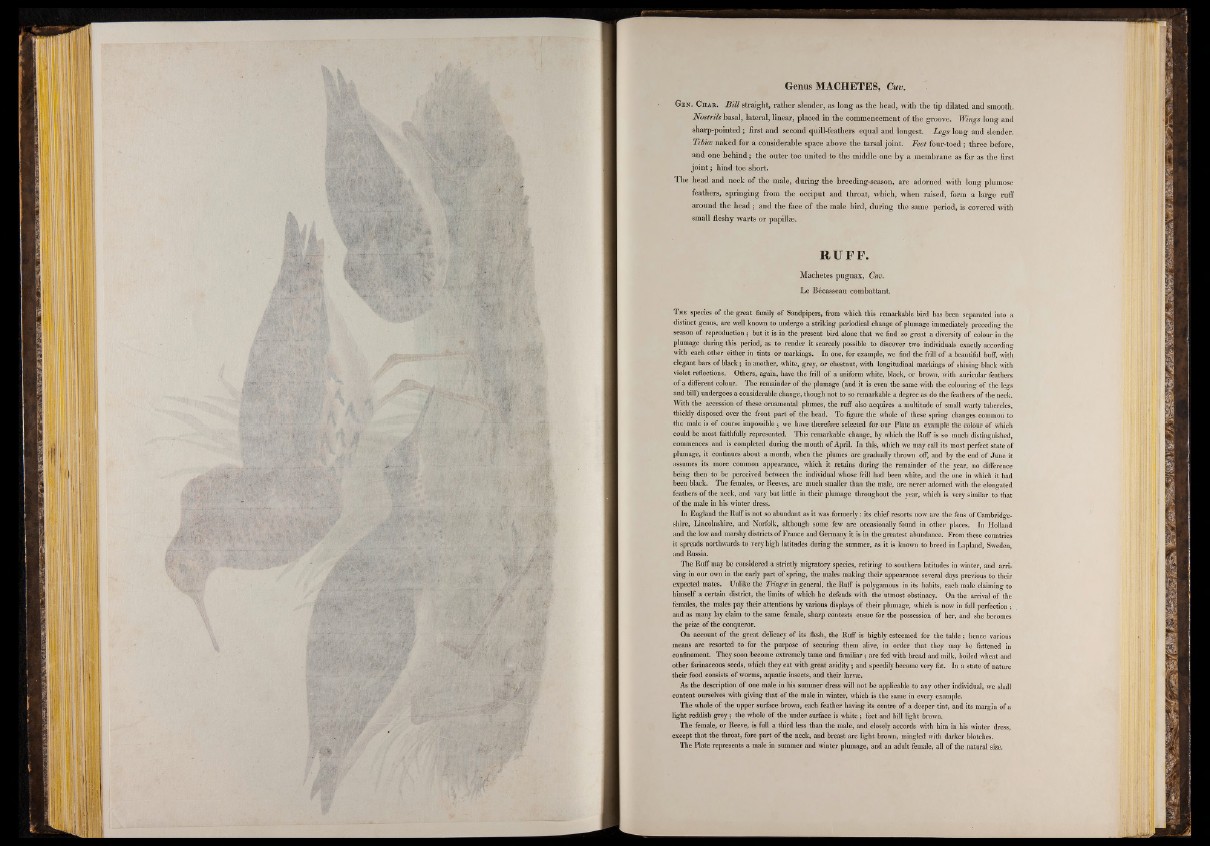
Genus MACHETES, Cuv.
Gen. Char. B ill straight, rather slender, as long as the head, with the tip dilated and smooth.
Nostrils basal, lateral, linear, placed in the commencement of the groove. Wings long and
sharp-pointed ; first and second quill-feathers equal and longest. Legs long and slender.
Tibioe naked for a considerable space above the tarsal joint. Feet four-toed ; three before,
and one behind ; the outer toe united to the middle one by a membrane as far as the first
joint ; hind toe short.
The head and neck of the male, during the breeding-season, are adorned with long plumose
feathers, springing from the occiput and throat, which, when raised, form a large ruff
around the head ; and the face of the male bird, during the same period, is covered with
small fleshy warts or papillæ.
RUFF.
Machetes pugnax, Cuv.
Le Bécasseau combattant.
T he species o f the great family o f Sandpipers, from which this remarkable bird has been separated into a
distinct genus, are well known to undergo a striking periodical change o f plumage immediately preceding the
season o f reproduction ; but it is in the present bird alone that we find so great a diversity o f colour in the
plumage during this period, as to render it scarcely possible to discover two individuals exactly according
with each other either in tints or markings. In one, for example, we find the frill o f a beautiful buff, with
elegant bars o f black ; in another, white, grey, or chestnut, with longitudinal markings of shining black with
violet reflections. Others, again, have the frill o f a uniform white, black, or brown, with auricular feathers
o f a different colour. The remainder o f the plumage (and it is even the same with the colouring o f the legs
and bill) undergoes a considerable change, though not to so remarkable a degree as do the feathers o f the neck.
With the accession o f these ornamental plumes, the ruff also acquires a multitude o f small warty tubercles,
thickly disposed over the front part of the head. To figure the whole o f these spring changes common to
the male is o f course impossible ; we have therefore selected for our Plate an example the colour o f which
could be most faithfully represented. This remarkable change, by which the Ruff is so much distinguished,
commences and is completed during the month o f April. In this, which we may call its most perfect state o f
plumage, it continues about a month, when the plumes are gradually thrown off, and by the end o f June it
assumes its more common appearance, which it retains during the remainder o f the year, no difference
being then to be perceived between the individual whose frill had been white, and the one in which it had
been black. The females, or Reeves, are much smaller than the male, are never adorned with the elongated
feathers o f the neck, and vary but little in their plumage throughout the year, which is very similar to that
o f the male in his winter dress.
In England the Ruff is not so abundant as it was formerly: its chief resorts now are the fens o f Cambridgeshire,
Lincolnshire, and Norfolk, although some few are occasionally found in other places. In Holland
and the low and marshy districts o f France and Germany it is in the greatest abundance. From these countries
it spreads northwards to very high latitudes during the summer, as it is known to breed in Lapland, Sweden,
and Russia.
The Ruff may be considered a strictly migratory species, retiring to southern latitudes in winter, and arriving
in our own in the early part o f spring, the males making their appearance several days previous to their
expected mates. Unlike the Tnngce in general, the Ruff is polygamous in its habits, each male claiming to
himself a certain district, the limits o f which he defends with the utmost obstinacy. On the arrival o f the
females, the males pay their attentions by various displays o f their plumage, which is now in full perfection ;
and as many lay claim to the same female, sharp contests ensue for the possession o f her, and she becomes
the prize o f the conqueror.
On account o f the great delicacy o f its flesh, the Ruff is highly esteemed for the table ; hence various
means are resorted to for the purpose o f securing them alive, in order that they may be fattened in
confinement. They soon become extremely tame and familiar ; are fed with bread and milk, boiled wheat and
other farinaceous seeds, which they eat with great avidity ; and speedily become very fat. In a state o f nature
their food consists o f worms, aquatic insects, and their larvæ.
As the description o f one male in his summer dress will not be applicable to any other individual, we shall
content ourselves with giving that o f the male in winter, which is the same in every example.
The whole o f the upper surface brown, each feather having its centre o f a deeper tint, and its margin o f a
light reddish grey ; the whole o f the under surface is white ; feet and bill light brown.
The female, or Reeve, is full a third less than the male, and closely accords with him in his winter dress,
except that the throat, fore part o f the neck, and breast are light brown, mingled with darker blotches.
The Plate represents a male in summer and winter plumage, and an adult female, all o f the natural size.